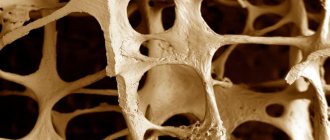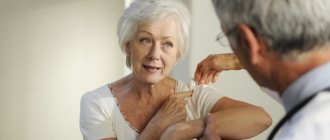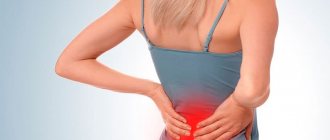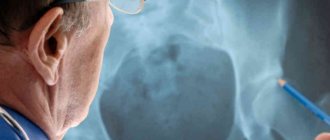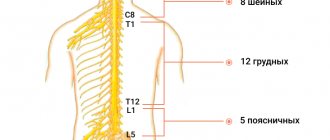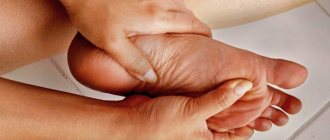Signs and symptoms of osteoporosis
Osteoporosis is a disease that produces few symptoms in the early stages. Signs of pathology appear as bone tissue weakens:
- back pain that occurs with osteoporosis due to destruction of the vertebra;
- slouch;
- reduction in human height;
- fractures even with minor impact (femoral neck fractures are especially dangerous - in 20-25% of cases they lead to death in the first 6 months after injury, and in 40-45% - to disability);
- loose gum tissue;
- pain in the joints, lower back;
- rapid fatigue due to physical exertion;
- discomfort when staying in one position for a long time;
- frequent bowel movements;
- thoracic kyphosis;
- heartburn;
- inability to take a full breath due to chest pain, feeling that there is not enough air;
- accelerated tooth decay;
- leg cramps.
You should consult a doctor for a preventative check if any of these symptoms occur, as well as in the following cases:
- treatment with corticosteroids for several months;
- the beginning of menopause;
- hip fracture in old age.
Early screening for osteoporosis is possible using a blood test, according to which we present the normal indicators according to the following criteria:
- total calcium – from 2.2 to 2.65 mmol/l;
- inorganic phosphorus – from 0.85 to 1.45 µmol/l;
- parathyroid hormone – from 9.5 to 75 pg/ml or from 0.7 to 5.6 pmol/l;
- DPID: for men (nmol DPID/mol creatinine) – from 2.3 to 5.4, for women – from 3 to 7.4;
- osteocalcin (ng/ml): for men - from 12 to 52, for women before menopause - from 6.5 to 42.3, for women after menopause - from 5.4 to 59.1.
Osteoporosis does not manifest itself until 20 to 30% of bone mass is lost. Therefore, after the age of 40, it is recommended to consult an endocrinologist for diagnostics once a year.
Types, forms and degrees of osteoporosis
This disease is classified according to several criteria. First of all, it is considered whether it is an independent (primary) disorder or a symptom of another disease (secondary).
Primary osteoporosis
This is juvenile, postmenopausal, idiopathic, senile osteoprosis.
- The juvenile type of the disease is typical for children and young people, is rare, and is most often caused by birth defects. The main manifestations are severe pain in the legs and back, curvature of the thoracic spine, and visible growth retardation. There is a tendency to compression fractures.
- The postmenopausal form is associated with accelerated bone loss in women 15 to 20 years after menstruation ceases. During this period, estrogens are produced in insufficient quantities and metabolism is disrupted. The disease can be acute or chronic and is accompanied by the occurrence of fractures of bones with a predominantly trabecular structure (vertebrae, distal parts of the radius) i Postnikova S.L. Features of postmenopausal osteoporosis / S.L. Postnikova // General Medicine. - 2004. - No. 4. - P. 41-45. .
- The idiopathic variety is more common in men, but in some cases it is diagnosed in women. The risk group by age is people 20-50 years old. The disease develops smoothly, primarily manifested by periodic pain in the spine, compression fractures are likely.
- Senile osteoporosis is associated with the aging of the body and occurs in both men and women after 70 years of age. Early symptoms are decreased vision, muscle weakness, and migraines. It manifests itself as loss of bone mass in both trabecular and cortical bone, which leads to femoral neck fractures i Postnikova S.L. Features of postmenopausal osteoporosis / S.L. Postnikova // General Medicine. - 2004. - No. 4. - P. 41-45. .
85% of cases of the disease relate to primary osteoporosis, mainly postmenopausal i Lesnyak O.M. Diagnosis, treatment and prevention of osteoporosis in general medical practice. Clinical recommendations / O.M. Lesnyak, N.V. Toroptseva // Russian family doctor. - 2014. - P. 4-17. .
Secondary osteoporosis
Secondary osteoporosis is a complication of various diseases (endocrine, inflammatory, hematological, gastroenterological) or drug therapy (for example, steroid).
Among the forms of secondary osteoporosis, the first place is occupied by glucocorticoid-induced osteoporosis (GIO), which develops in people of any age as a result of therapy with systemic glucocorticosteroids (SGCS).
In elderly patients, a decrease in bone density during long-term therapy with SGCS occurs 2-3 times faster than under physiological conditions. Osteoporotic fractures are reported in 30-50% of patients receiving long-term treatment with glucocorticosteroids. When taking glucocorticosteroids in a daily dose of >5 mc, the risk of fractures increases by 1.9 times compared to the general population, hip fractures by 2 times, vertebral fractures by almost 2.9 times i Baranova I.A. Glucocorticoid-induced osteoporosis / I.A. Baranova // Practical pulmonology. - 2008. - No. 1. - P. 3-9. .
Degrees of osteoporosis
- I (light). Bone density is slightly reduced, sometimes the patient experiences pain in the limbs or spine, and muscle tone decreases. Signs of low calcium levels in the body also appear: dry skin, hair loss, brittle nails.
- II (moderate). Structural changes in the bones are pronounced, the pain becomes constant, and due to damage to the spine, stooping appears. The pain syndrome intensifies with exercise, cramps appear in the calves, and disturbances in the functioning of the heart muscle.
- III (severe). Most of the bones are destroyed, the patient has poor posture, reduced height, and experiences constant severe back pain. Several parts of the spine are affected at once, increasing the risk of fracture of the femoral neck and collarbone.
- IV (very severe). On the x-ray, the bones are almost transparent, the vertebrae are “flattened”, and therefore the patient’s height is significantly reduced, the spinal canal is expanded, and the shape of the bones is changed. At this stage, the patient cannot care for himself.
By localization
The most severe form of the disease is damage to the spine. This increases the risk of getting a fracture and losing the ability to move. Based on localization, the following types of osteoporosis are distinguished:
- Cervical region. The length of the neck decreases, the angle of the head changes. Patients complain of dizziness, nausea, and muscle pain. There is a high risk of pinching the artery that supplies oxygen to the brain.
- Thoracic department. Posture changes noticeably, heart rate increases, and nails become brittle.
- Lumbar region. In this case, the lower back “sags” inward, which reduces the distance between the pelvis and ribs and causes an increase in the abdomen.
By joint damage
Osteoporosis can affect various joints:
- Hip. It is most often affected in old age and leads to disability due to the very low rate of bone tissue restoration. If combined with a spinal fracture, the patient becomes disabled.
- Knee. The cartilage wears out, movement becomes difficult, and severe pain occurs due to the fact that the bones are in contact with each other.
- Ankle. At the same time, it is difficult for a person not only to walk, but also to be at rest. My foot and lower leg hurt constantly.
What it is
Osteoporosis is a systemic chronic bone disease characterized by metabolic disorders. In bones, the processes of catabolism prevail over the processes of bone formation, as a result of which bone density deteriorates. The disease has been known since ancient times, but the theory of osteoporosis was clearly described by William Albright in 1984.
In women, the pathology occurs twice as often as in men. The disease progresses already during menopause. This is due to a decrease in estrogen production, resulting in decreased calcium absorption in the intestines.
Ten years after the onset of menopause, bones lose a third of their strength. The pelvic bones, spine, and skull are especially affected. Osteoporosis is the leading cause of fractures in women.
Osteoporosis is characterized by loss of bone density
The disease develops in several stages:
- Disorders of calcium, phosphorus, and vitamin D metabolism.
- Imbalance between the processes of bone formation and the processes of their destruction.
- Decreased bone mass, thinning of the cortical bone.
- Reduced bone strength, which leads to bending and fractures.
In medicine, several classifications of osteoporosis are accepted. Depending on the causes of development, primary and secondary types of the disease are distinguished.
Primary develops due to age-related changes in the body . Divided into:
- Climacteric.
- Senile.
- Idiopathic (develops at a young age for unknown reasons).
In women, osteoporosis develops most often due to age-related changes and menopause.
Secondary osteoporosis is a consequence of various diseases of internal organs and systems.
Depending on which layer of bones is affected, there are:
- Cortical osteoporosis (cortical substance is destroyed);
- Trabecular (spongy substance decreases);
- Mixed.
Diagnosis of osteoporosis
You can check the condition of the body and confirm or exclude the diagnosis of osteoporosis using laboratory tests and instrumental studies, of which the simplest and most informative is densitometry.
Lab tests:
- calcium in urine;
- clinical blood test;
- alkaline phosphatase (biochemistry indicator);
- TSH;
- markers of bone destruction;
- for men – testosterone.
Instrumental methods:
- radiography;
- densitometry;
- bone biopsy;
- bone scintigraphy;
- MRI.
How to check for osteoporosis using densitometry?
Ultrasound densitometry is a quick and painless diagnostic method. During the procedure, the speed of propagation of ultrasound waves through bone tissue is measured. Ultrasound travels faster through denser bones. The result of the study is recorded by a computer, the indicators are compared with the norm. The session lasts 2-3 minutes, and a conclusion is immediately issued.
To carry out this diagnosis, a Sonost-3000 densitometer is used - expert-level equipment that can detect loss of even 2-5% of bone mass.
Densitometry is recommended:
- nulliparous women;
- women over 45 years old;
- women who have given birth to 2 or more children;
- during early menopause;
- in case of menstrual irregularities;
- if you have bad habits;
- men over 50 years old;
- in case of deficiency of sex hormones.
You definitely need to undergo ultrasound densitometry if:
- Fractures often occur;
- there was a long course of glucocorticosteroids, diuretics, anticonvulsants and anticoagulants;
- diagnosed with hyperparathyroidism or other dysfunction of the parathyroid glands.
Also indicated are:
- change in posture;
- bone and muscle pain due to changing weather;
- pain in the lower back and chest with static load;
- senile stoop;
- night cramps in the legs;
- tooth decay;
- decreased growth;
- body weight deficiency;
- osteoporosis in close relatives;
- low testosterone levels in men;
- and etc.
What diet is necessary for osteoporosis?
The diet for osteoporosis has no special secrets - you just need to ensure sufficient intake of vitamin D and calcium into the body, which are necessary for the formation of new bone tissue. The richest foods in calcium are dairy products, fish, cabbage (including broccoli), and various nuts. The main source of vitamin D in the body is fish (or fish oil). Significant amounts of vitamin D are produced in the skin when exposed to sunlight.
At the same time, when planning nutrition for osteoporosis,
It should be remembered that dietary “exercises” alone are not able to eliminate either calcium deficiency or vitamin D deficiency. In the vast majority of cases, diet is only one element of the treatment of osteoporosis and must be accompanied by taking calcium and vitamin D supplements in the form of tablets - this is the only way eliminate long-term chronic vitamin D deficiency.
Osteoporosis therapy and clinical recommendations
First of all, you need to know which doctor treats osteoporosis: since the causes of the disease can be different, different specialists can treat it - a rheumatologist, an orthopedic traumatologist, an endocrinologist.
Effective treatment of osteoporosis (both early and after 50 years) may include physiotherapeutic procedures, medication, lifestyle and diet adjustments, and physical exercise.
Drug therapy
- Taking vitamin D and calcium supplements. Consumption of these elements in the right dosages leads to a rapid increase in bone mineral density and a decrease in the incidence of fractures.
- Bisphosphonates. Treatment with these drugs reduces the risk of fractures by 30-50% and increases bone density.
- Hormone therapy (replacement). It is carried out for the prevention and treatment of the postmenopausal form of the disease. Treatment leads to the cessation of bone thinning, the prevention of fractures, and the elimination of urogenital and autonomic complications of menopause.
- Calcitonins. They inhibit bone tissue resorption and have a pronounced analgesic effect.
- Ossein-hydroxyapatite complex. Normalizes calcium homeostasis, improves bone metabolism, stimulates bone formation, restores the balance between the processes of bone formation and resorption.
Non-drug therapy
- Wearing a corset (orthoses)
Indicated for back pain and compression fractures of the spine. The corset should be worn constantly or intermittently, always taking it off at night.
- Physical education, walking, aerobic exercise.
Regular walks in the fresh air are beneficial. Loads should not be excessive; it is necessary to exclude power sports and those that involve the likelihood of mechanical impacts (for example, playing with a ball).
Causes
Did you know that...
Next fact
Osteoporosis is considered a polyetiological disease, that is, arising for many reasons.
The main causes of osteoporosis in women:
- Hormonal imbalance caused by menopause. Moreover, early menopause, which arose due to the removal of the ovaries, also leads to the appearance of the disease. Women with low sexual activity who have not given birth are at risk.
- Endocrine disorders in which hormonal imbalance occurs (hypothyroidism, thyrotoxicosis, diabetes mellitus).
- Autoimmune diseases (rheumatoid arthritis, lupus erythematosus, ankylosing spondylitis).
- Malignant blood diseases (leukemia, lymphoma, anemia).
- Chronic renal failure.
- Organ transplantation.
- Radiation therapy.
- Poor nutrition associated with a lack of vitamin D and calcium. Vegetarians are especially susceptible to the disease.
- Long-term use of certain drugs (glucocorticosteroids, anticonvulsants, cytostatics, antibiotics).
A decrease in female hormones directly contributes to changes in bone structure
There are also several factors that provoke the development of the disease.:
- Alcoholism.
- Smoking.
- Physical inactivity.
- Excessive physical activity.
- Obesity.
- High growth.
- Heredity.
Video: “What is osteoporosis and how to treat it?”
Complications from osteoporosis
The main complication is injuries to the musculoskeletal system, especially compression fractures of the spine and microfractures due to sudden compression of the joints. In this case, a large load is not necessary; you can simply trip and fall, resulting in a fracture.
, compression of the spinal cord and nerve endings may occur . Because of this, loss of sensitivity in various parts of the body, as well as paralysis and disability, is possible.
Fractures are especially dangerous in old age - only 9% of people (according to statistics for the Russian Federation) return to normal life after this.
Osteoporosis can also have the following consequences:
- impediment to growth, which is especially important for a child or adolescent;
- decrease in height - approximately 2-4 cm per year;
- poor posture – “hump” in the thoracic region (thoracic kyphosis);
- disruption of internal organs due to incorrect posture.
Treatment
Carrying out functional treatment of vertebral fractures in elderly people due to osteoporosis is largely difficult due to the risk of developing hypodynamic complications; the use of fixing corsets and orthoses in such patients is significantly limited due to their intolerance and the risk of exacerbation of cardiopulmonary failure. Traditional surgical methods for treating vertebral fractures are associated with significant trauma and blood loss, which can be fatal for the body of an elderly person.
Sources
- Baranova I.A. Glucocorticoid-induced osteoporosis / I.A. Baranova // Practical pulmonology. - 2008. - No. 1. - P. 3-9.
- Baranova I. Caution: osteoporosis! / I. Baranova // Asthma and allergies. - 2004. - No. 4. - P. 18-19.
- Zulkarneev R.A. Prevention and treatment of osteoporosis / R.A. Zulkarneev, R.R. Zulkarneev // Kazan Medical Journal. - 2003. - T. 84. - No. 3. - P. 230-232.
- Lesnyak O.M. Diagnosis, treatment and prevention of osteoporosis in general medical practice. Clinical recommendations / O.M. Lesnyak, N.V. Toroptseva // Russian family doctor. - 2014. - P. 4-17.
- Postnikova S.L. Features of postmenopausal osteoporosis / S.L. Postnikova // General Medicine. - 2004. - No. 4. - P. 41-45.
- Rodionova I.V. Systemic osteoporosis and osteoporosis of the lower jaw / I.V. Rodionova [and others] // Nurse. - 2015. - No. 5. - P. 32-34.
